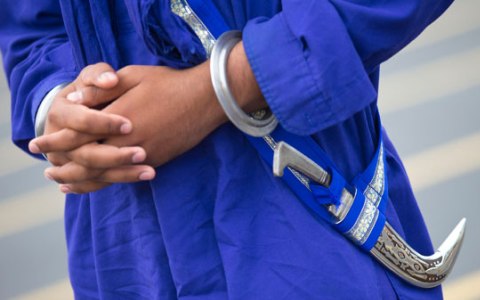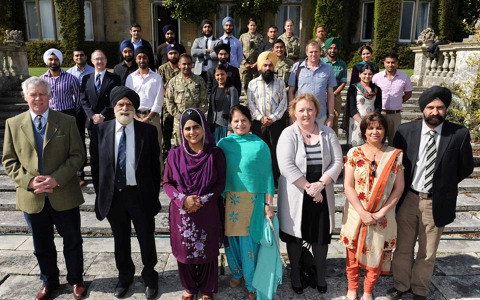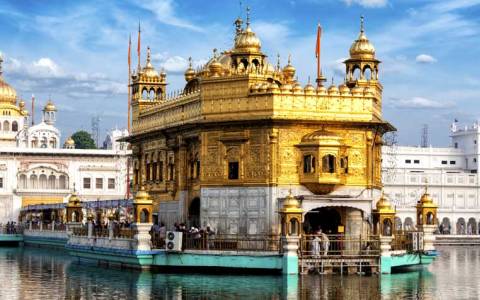BRIEFING Khalsa, caste and Khalistan: Sikh mobilization counters Britons' identity deficit
by - 22nd September 2016

THE confrontation between police and protesters at a Sikh temple in Warwickshire reflects increased mobilization of religious fervour among Sikh youth.
It is significant that all the protesters at the Leamington Spa gurdwara, protesting against an interfaith marriage were under the age of 40. [See our News Focus here.]
‘What you’re seeing now is kind of a revival in the Sikh spirit and the Sikh culture,’Jagraj Singh told Lapido.
Jagraj is an Oxford-educated Sikh who set up the Basics of Sikhi YouTube channel, which teaches Sikhism in English. ‘People can call it fundamentalism.... [I’d say it’s] going back to the basic principles of the faith.’
Sikhs emigrated to the UK throughout British rule in India, but the largest movement of people came from the Punjabi region of India in the 1950s and 1960s, in response to the demand for labour in the industrial sector. At the last census in 2011, there were 423,000 people who identify as Sikh in the United Kingdom.
Sikhism is a relatively new religion. Its roots go back to the fifteenth century and the first Guru Nanak. Nine other Gurus followed, and their teachings consolidated into the Guru Granth Sahib, the main holy scripture of Sikhism.
It was the tenth and last Guru, Gobind Singh, who created the ‘5Ks’ of the Sikh faith: wearing a bangle (Kara), a dagger (Kirpan), a wooden brush (Kangha), cotton underwear (Kachera) and not cutting the hair (Kesh).
He promoted the concept of the ‘warrior saint’ which the kirpan represents: fighting for good. Sikhs campaigned to be allowed to wear a kirpan in the UK, and are even allowed a small kirpan on public transport.

Twenty years ago there would be few Sikhs wearing turbans or a long beard at a Gurdwara [a Sikh temple]: that has changed significantly. There are new Sikh education organizations, running retreats, feeding the homeless, and protesting about what they see as lax standards in the temples.
More liberal members of the Sikh community have expressed concern in the change.org campaign petition, ‘Help Stop the Religious Radicalisation of Young British-Born Punjabi/Sikh males. Stop religious radicalisation before these individuals carry out an atrocity on the British public or authorities.’
The petition claimed there is a ‘carefully orchestrated militia with frequent use of violence.’
It cited incidents such as an emotionally charged protest in Central London last October, and a Sikh man caught with a large cache of weapons as examples of how younger Sikhs are being radicalized.
Such terms are eschewed by other senior members of the community, who say comparisons with radicalized Muslims are not valid.
‘This idea of radicalization is a myth,’ said Gurmel Singh, the secretary general of the Sikh Council UK, a representative body. ‘People are using the wrong terminology and using terms used for Muslim young people for example. That terminology doesn’t translate straight across.
‘None of these [protesters] have a link to terrorism, none are involved with any kind of activity, guns, anything considered to be serious,’ says Kamalroop Singh, a community organiser who holds a PhD in Sikhism. ‘So we have to be very careful what we call them.
‘Yes they’re out there and stick out like sore thumb. But to call them fundamentalists – essentialistic, or radical… I wouldn’t say they’re a threat to the country or the community.’
Peaceful
For Sikh Youth UK, any association between the increased religious fervour of their members and other kinds of religious extremism is not acceptable.
They say their protests are peaceful, and the masks the protesters wear are to protect their livelihoods and potential persecution from the Indian government, which watches any kind of Sikh radicalism closely.
They also don’t like terms such as conservative and liberal. ‘We won’t put the label hardliners on them,’ says Jasveer Singh Gill, at the Sikh Press Association, which represents the protesters.
‘We believe that they want to follow Sikhi. I’m adamant we can’t place these labels – orthodox, conservative, hardline, liberal. We don’t want to cause these divisions.’
Media
There is little doubt that many younger Sikhs are taking their religion more seriously than ever before. So what is causing young Sikh men to protest so passionately?
A significant influence on the community is the proliferation of niche media outlets, on TV and via the internet. Eight years ago there were no Sikh TV channels in the UK; now there are three. ‘They have all come in the last eight years,’ says Gurmel Singh, the secretary general of the Sikh Council UK. ‘There has been this awakening and rediscovery of the deeper meaning of the faith.’
Until recently, gurdwareh often taught in Punjabi, so those who don’t speak it well, such as British-born Sikhs, were excluded from understanding the meaning behind the faith.
‘There’s a massive growth in Sikhi being taught in English,’ says Jasveer. ‘It has made it a lot easier for people to understand their religion.
‘Previously, the gurdwara was just somewhere you would go on a Sunday, you wouldn’t know the meaning.’
In the past five years, groups such as Sikh2Inspire, and Everythings 13, have produced large numbers of YouTube videos that explain aspects of the Sikh religion and answer typical questions.
But why is there an interest in these issues? After all, many British people in younger generations seem less interested in religion, not more.
Jagraj set up the Basics of Sikhi YouTube channel after a religious awakening led him to reject drinking, partying and other ‘Western’ habits.
He says many other younger Sikhs are doing the same. ‘A lot of the people that are my age, in 30s, they’ve lived a very Western lifestyle, and they find that there is still something inside them that is not satisfied,’ he said. ‘There is a desire for something spiritual.
‘When you experience the spiritual side, you realize how beautiful and attractive it is.’
Traditions
Some propose less religious reasons for the changes, but instead look to a wider culture of anti-religiousness.
‘People are really clinging on to their traditions,’ said Kamalroop. ‘There is a declining religiosity… an overt form of religion is looked down upon. There’s a disdain for it. So a lot of religious communities are trying to find themselves, trying to keep their principles.'
‘It’s not necessarily a Sikh thing, but generally there seems to be in the world a move towards more of the conservative, more radical viewpoints when relating to faith,’ says Onkardeep Singh Khalsa, a community organizer.
‘The easiest way to establish your identity is to say, here are the facts and draw a line and say I’m on this side of the line…
'It’s very difficult for someone who isn’t confident in their identity, as many young people are, to take a liberal point of view, as there is a fuzzy line and it doesn’t give self-confidence; rather than saying “This is what I believe” which gives confidence.’
For others, it’s just about the spirituality. ‘It’s more specifically to do with reconnecting back with Sikhi,’ said Jasveer. ‘When previous generations came here, foremost in their mind was earning money so the next generation can be educated and comfortable.
“Now we’re at a stage where Sikhs are comfortable and well embedded in society and culture… there is a thirst to understand where we came from and our history and what it means to be a Sikh. That’s foremost.
‘Sikhs are liberal by nature. There is no stipulation that ‘these people are against us, we must be divided from them’.’
Dabinderjit Singh, from the Sikh Federation, a political pressure group, says that the desire for religion has increased over time.
‘In the 1950s, my father was a Sikh in a turban who cut his hair because there was discrimination and he wouldn’t have got a job,’ said Dabinderjit. ‘They compromised their faith and fitted in to get jobs, for economic reasons.’

But 1984 became a defining moment for Sikhs around the world, when the Indian government army stormed the Golden Temple leading to significant loss of life and subsequent riots.
‘Sikhs living in this country who had lost their identity, who lost their turbans and cut their hair, saw their holiest of holy places was being attacked by their own government. I know so many stories of so many people, who said overnight, I am going to stop drinking, and wear my turban… in that one moment.’
Confidence
He also cites the creation of Sikh schools as a factor in giving people more interest and connection with their roots. ‘Various things happen now that never happened when I was a kid. They have Punjabi classes… I had to teach myself Punjabi when I was young. Younger people have more opportunities to take part in various aspects of the Sikh way of life as well as the internet.’
Another aspect to the increased confidence of the Sikh community is organisation. In the past six years, many organisations have been developed either to represent Sikh interests or consolidate them.
At the last UK General Election, one of these organisations The Sikh Network created a ‘Sikh Manifesto’ for the first time. It had ten objectives that chime with the concerns of more fervent Sikhs, such as: better representation in Parliament, erecting a monument to honour the Sikhs killed in World War I, and an inquiry into the 1984 Sikh genocide. The manifesto declares: ‘Based on the results of the 2010 General Election there are sufficient Sikh voters alone to determine who will be elected in around 80% of the 50 target seats.’
Sikhs have long been adept at achieving their cultural and legal objectives in UK with a quiet determination that has often gone unnoticed by the country as a whole.
In 1983 a campaign to allow a Sikh boy to wear his turban in a Christian-based school successfully established in law a definition of ethnicity that incorporated religion, granting religious rights to ethnic minorities distinctive from the mainstream population.
The ruling was based on numbers and religious boundaries, and set a precedent that has acted to reinforce multicultural 'enclavement' or ghettoes.
Sikhs were also the first to be granted exceptional rights in European law not to wear hard hats on construction sites or crash helmets on motorbikes. This was extended in 2014 to cover all work places.
Their hard-won identity and separatism was challenged in 2011 over allegations of caste-discrimination against two Asian former employees of a Birmingham law firm who wanted to marry despite their different 'castes'.
The couple brought 110 allegations of harassment, victimisation and humiliation against their employers, though the tribunal collapsed two years later.
Philanthropy
In calling from Britain for a Sikh independent state in India, often dubbed ‘Khalistan’, the Sikh Network is proposing a manifesto that the Indian Government perceives as extremist and is concerned about.
Yet activists deny this is the case. ‘To say they are radicals or extremist, is contrary to everything the Sikh faith stands for,’ says Jasveer. ‘Whilst there has been a rise in protests… that also encompasses a massive growth in Sikh philanthropy.’
These revived Sikhs are inspired by the example of their gurus and by a heightened sense of transcendence, to go out and do community work to try to reduce drug use, and giving meals to the homeless, for example, he says.
Conservative practitioners of any faith often express frustration that their passion is associated with negative events, especially when much of the teaching concerns the oneness of creation (ek), the illusion of suffering (sansar) and the sacrifice of the saints.
What the Sikh community becomes associated with in the future will depend on the direction newly revived Sikhs take this new energy.
